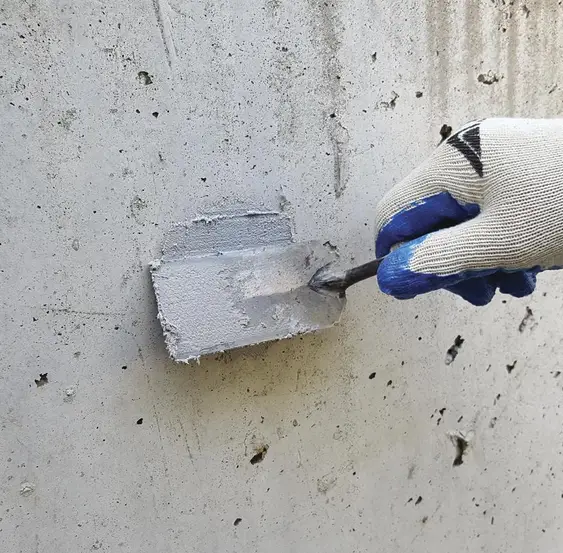This is the fifth article in a series of articles on concrete repair work. Here we are going to discuss how to repair honeycombs larger than 75mm using ready-mix concrete and how to rectify cracks in watertight structures.
Table of Contents
Concrete repair work using ready mixed concrete
Ready-mixed concrete with the same grade or a higher grade can be used for voids and honeycombs larger than 75mm.
Area Preparation
- Remove the broken concrete with a hacksaw to reveal a sound surface.
- Oil, grease, laitance, and loosely adhering particles should not be present on concrete surfaces. They should also be clean.
- Formwork with an adequate inlet, level checking, a sealing opening, and a drain out plug should be formed and installed.
- Openings and formwork must be properly sealed.
- Create a head for easier flow by preparing a platform on the top side (if required).
- The substrate must be properly saturated by filling the formwork with clean water a few hours before pouring or performing repairs. Before starting work, drain the water out.
Rectification Method
- As stated previously, prepare the area.
- Immediately pour the concrete into the installed formwork.
- If necessary, a vibrator or poker should be used for large volumes.

Curing
Rapid water evaporation, which can lead to the formation of surface cracks, must be prevented on the exposed surfaces of concrete. During the first 24 hours of curing, spray water or use an anti-evaporant on surfaces that are exposed to the air.
Now, let’s learn about repairing structural cracks in watertight structures. One could interpret EN 1992-3 to mean that leaking full-depth cracks are acceptable for structures used to retain water. Designers sincerely believe that full depth cracks between 0.05 and 0.20 mm are acceptable, depending on the hydraulic gradient. However, this is only true if the cracks effectively close on their own within a short period of time.
Unfortunately, cracks do not always heal on their own, and reinforced concrete structures are susceptible to severe reinforcement corrosion, which could jeopardize the structural integrity in the absence of preventative measures such as epoxy injection.
Repairing of structural cracks in watertight structures
For the repair of cracks and voids in watertight structures, HA Cut CFL AF and Masterseal® 590 must be used in conjunction.
Concrete repair work using HA Cut CFL AF and Masterseal® 590
First let’s discuss the expected application procedure for HA Cut CFL AF.
HA Cut CFL AF
HA Cut CFL AF is a phthalate-free, dark-brown, non-flammable liquid in its uncured state. The next-generation l-component injection resin, HA Cut CFL AF, has better waterproofing and water-cutting capabilities.

The grout expands when exposed to water and cures quickly (depending on temperature and the amount of catalyst HA Cut Cat AF used) to a tough, semi-rigid, closed-cell polyurethane foam that is typically unaffected by corrosive environments.
Area Preparation
- In order to determine the crack or joint’s pattern, clear the surface of any surface contaminants and debris. With Masterseal® 590 – WATERPLUG, active leaky cracks larger than 3 mm must be repaired.
- For the chosen packer, drill holes with the proper diameter. Use a 45° angle when drilling.
- If the crack is not perpendicular to the concrete surface, it should ideally have the holes drilled in staggered fashion to ensure good coverage of the crack.
- Approximately half the thickness of the concrete should be the bore’s depth.
- The drill point should be placed half the thickness of the wall away from the crack.
- Depending on the specific site conditions, the space between holes can vary from 15 to 90 cm.
- Fill the hole with the appropriate-sized packer up to two-thirds of its length.
- Once there is enough tension to hold the packer in place during injection, tighten with a wrench or spanner by turning clockwise.
- Water should be injected into the crack before resin. Dust and debris will be flushed out, the crack will be primed for the injection resin, and the product’s penetration into the crack will be improved.
- The resin will be activated by water in the crack.
Mixing
- Make the resin with the specified amount of catalyst. Before using, thoroughly shake HA Cut Cat AF.
- There will be no reaction with the resin until it comes into contact with water.
Rectification Method
- Inject at the first packer.
- Begin injecting with the pump’s lowest pressure setting. Increase the pressure gradually until the resin starts to flow. Pressures can range from 14 to 200 psi, depending on the size of the crack, the thickness of the concrete, and the overall condition of the concrete.
- A small amount of resin leakage through the concrete or crack can be used to determine the extent of resin travel. Large leaks should be plugged with rags, then inject again after the resin has set.
- Water will flow from the crack first, followed by foaming resin. Pure resin will then flow from the crack.
- When the pure resin has reached the next packer, stop pumping.
- Repeat the process with the next packer.
- After injecting through a few of the packers, return to the first one and re-inject resin.
- After the resin injection, water can be re-injected into the ports to cure the resin that was left behind.
- Allow the resin to fully cure before removing the packers. The resulting holes can be filled with Masterseal ® 590 – WATERPLUG.
In our next article, we will discuss the application of the WATERPLUG and different curing methods.
See this: Concrete Repair Work – Part 1
See this: Concrete Repair Work – Part 2
See this: Concrete Repair Work – Part 3
See this: Concrete Repair Work – Part 4
See this: Concrete Repair Work – Part 6












